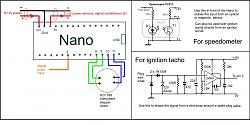So here is my problem. It is quite difficult to get good resolution on a high revving engine when all the tick marks are crammed into a 270-300 degree clock face. For example, if a shift point is around 9,500-10,000 rpm, usually everything (in my application) below 6,000-7,000 rpm is useless noise. I would love to display only the top 2,500-3,000 rpm in that same 300 degree window with the correspondly wider tick marks giving much better resolution. My apologies to our motorcycle friends for inferring that 10k rpm was a high number.



 LinkBack URL
LinkBack URL About LinkBacks
About LinkBacks



 Reply With Quote
Reply With Quote




Bookmarks